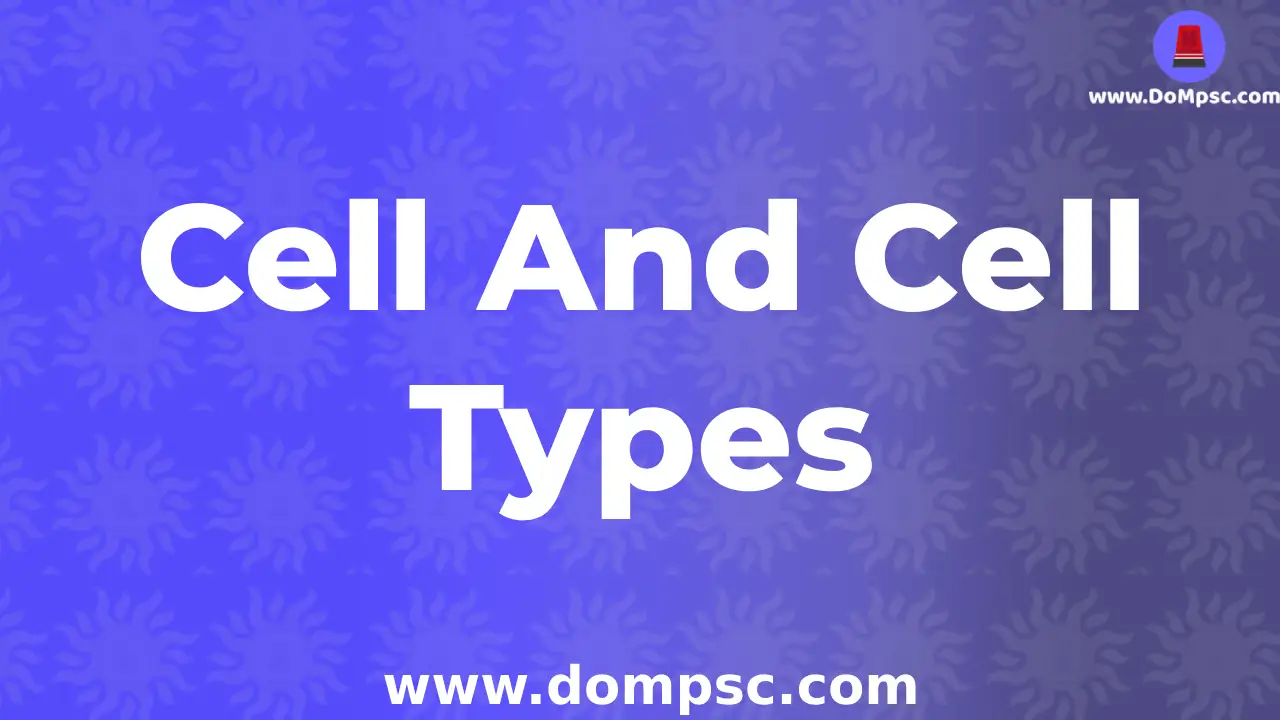MPSC Cell(पेशी)-MPSC Biology science notes
Cell(पेशी)
Table Of Contain-Mpsc Cell(पेशी)
✪ Download pdf Works Properly on chrome Browser ✪

Introduction of Cell(पेशी)

By Shubham Vyawahare
0-May-2025
➤cell is the smallest part of a body.
➤Every cells has its quality and special functionality.
➤ In Latin Cell means a small rooms
➤ It Was Discovered by Robert hook in 1665.
➤ Every Living and non living things are made up of cells.
➤ The Study of cell know as Cytology(पेशी विज्ञान).
➤ CellS are made up with existing cells.
➤ Cells Are the Functional and fundamental components of a body.
✪ Types OF Cell ✪
Eukaryotic Cell
➤ Cell with a membrane bound Organelle are known as Eukaryotic Cell.
➤ Well Defined Nucleus.
➤ large shape cells almost 5-10 micrometer.
➤ It found in developed living animals like humans .
Prokaryotic Cell
➤ Cell without a membrane bound Organelle are known as Prokaryotic Cell.
➤ Not Defined Nucleus.very Simple Cell
➤Less functional components found like Plasma membrane cytoplasm.
➤ Very Small in shape.
✪ Structure Of Cell ✪
➤Cell Are the building blocks of a body.
1.ShapeOfCell
➤Cells have a different sizes range from 0.1um to 18 cm
➤ Generally cells are smaller in shape.
➤ Unit of cell shape calculation is micrometer.
➤ Nervous cell is the longest cell in human body.
➤ Eggs cell is the biggest cell in human body.
➤ Cell shape are depends on there working.
✪ Cell Body Structure ✪
➤ Following are the main 4 component of a cell structure
- Cell Wall
- Plasma
- CytoPlasma
- CellOrganelles
Cell Wall
➤ Outer shape of a body
➤ It prevents cell from any damage.
➤ Generally Found in plant body
➤ It found in a outer side of cellulose plasma membrane
➤ The Main functional work of a cell wall is to protect a cell structure and protect from damages.
➤ Cell Perform a osmosis effect
➤ Means it change its shape with physical conditions
Plasma
➤ The plasma membrane refers both to the membrane that surrounds cells and also to the membranes that surround organelles within the cel
➤The membrane is made of a lipid bilayer (the red/orange/yellow stuff in the above diagram).
➤ The plasma membranes of mammalian red blood cells (erythrocytes) have been particularly useful as a model for studies of membrane structure.
➤ The bilayer structure of the erythrocyte plasma membrane is clearly evident in high-magnification electron micrographs.
➤ This are the functions of plasma membrane A Physical Barrier Selective Permeability Endocytosis and Exocytosis. Cell Signaling Proteins. Carbohydrates Fluid Mosaic Model.
➤Size of a plasma membrane is 20 nm thick.".
➤Fiber-rich foods such as whole grains, leafy vegetables and fresh fruits will add bulk to your feces and help stimulate the bowel to push food along
➤membrane found in all cells that separates the interior of the cell from the outside environment. In bacterial and plant cells
➤Plasma membrane maintain homeostasis (the state of steady internal, physical, and chemical conditions maintained by systems).
CytoPlasma
➤ The Outer side of a cell is cytoplasma ➤Found in plasma and nucleolus membrane
➤Its very sticky in nature
➤It perform chemical reactions of cell.
➤It is a storage unit of cell.like to store amino acid and glucose
Cell Organelles
➤ The Functional and executive part of body divide in further components.
Nuclues
➤ Central part of a cell.
➤ Take place in the all functional work.
➤ It is like a brain part of cell.
➤ Perform all the operations
➤ Control all work and body balances
➤This part has a lots of holes so water comes ouside in a cytoplasm.
➤It Consists a pair of chromosomes and maintain a network of chromosomes
EndoPlasmic Recticulum
➤ The endoplasmic reticulum is a type of organelle made up of twounits rough endoplasmic reticulum (RER), and smooth endoplasmic reticulum (SER) ....
➤ Co related with inner and outer membrane.
➤ The endoplasmic reticulum is only present in the eukaryotic cells. However, the occurrence of the endoplasmic reticulum varies from cell to cell. .
➤ The endoplasmic reticulum acts as secretory, storage, circulatory and nervous system for the cell. It is also the site of the biogenesis of cellular membranes.
➤ The cavity of the endoplasmic reticulum is well developed and acts as a passage for the secretory products.
➤endoplasmic reticulum may occur in the following three forms: Lamellar form or cisternae Vesicular form or vesicle and Tubular form or tubules. .
Golgi Appratus
➤ Found by a Goldi scientist.
➤ know for the Chemical factory of cells.
➤ Lots of enzymes present here.
➤ Functions of a GolgiAppratus Formation of secretory vesicles and secretion, Helps in enzyme formation, Production of hormones, Storage of protein.
Lysosome
➤ Not Found in the rbc of mammals.
➤ Lysosomes are spherical, membrane bound organelles that are generated by the golgi apparatus. They contain hydrolytic enzymes, and so function as part of the recycling system of the cell..
➤ This is the digestive systems of a body.
➤ The lysosomes are located in the cytosol of the cytoplasm in a eukaryotic cell. Take note that lysosomes are only found in animal cells and not plant cells.
➤ Each lysosome is surrounded by a membrane that maintains an acidic environment within the interior via a proton pump.
➤Lysosomes contain a wide variety of hydrolytic enzymes (acid hydrolases) that break down macromolecules such as nucleic acids, proteins, and polysaccharides.
Mitochondria
➤ 50 to 500 Mitochondria found in cell.
➤ Storage house of a energy.
➤ phosphate molucule and DNA found in Mitochondria vault.
➤ Mitochondria are functional body of inhalation of oxygen
➤ The mitochondrion is the site of ATP synthesis for the cell
➤The number of mitochondria found in a cell are therefore a good indicator of the cell's rate of metabolic activity; cells which are very metabolically active, such as hepatocytes, will have many mitochondria.
Plastids
➤ Central part of a cell.
➤ Take place in the all functional work.
➤ It is like a brain part of cell.
➤ Perform all the operations
➤ Control all work and body balances
➤This part has a lots of holes so water comes outside in a cytoplasm.
➤It Consists a pair of chromosomes and maintain a network of chromosomes
Vacuoles
➤ It Store a liquid and food component in cell.
➤ Plant have a large Vacuoles than the animals.
➤ Vacuoles Found in a plants are permanent and other hand its not permanent in animals.
➤ a space within a cell that is empty of cytoplasm, lined with a membrane, and filled with fluid
➤ contribute to the rigidity of the plant using water to develop hydrostatic pressure
➤ store nutrient and non-nutrient chemicals.
➤ Remove and store harmful foreign products so they don't damage the cell.
Others Blogs Related to MPSC Biology Notes
➤Biology Exam Pattern
➤Blood Circulation System
➤Blood Groups And Its Diseases
➤Balanced Diet And Nutrients
➤Classification Of Animals
➤Classification OF Plants
➤Cell
➤Tissue
➤Coordination In Human
➤Digestive System
➤Diseases And Disease Types
➤Excretory System
➤Respiratory System
➤Reproductive System
➤Skeletal System
Read All MPSC blogs
- ➤केंद्र सरकारने खाजगी क्लासेस साठी नवी नियमावली लागू केली आहे |GUIDELINES FOR REGULATION OF COACHING CENTER in marathi
- ➤MPSC Data leak: पेपर न फुटल्याचा दावा MPSC आयोगाने स्पष्टपणे केला आहे
- ➤MPSC hall ticket data leaked before 6 days of exam
- ➤MPSC Data leak: टेलेग्राम वर अचानक ९० हजार परीक्षार्थींचे प्रवेशपत्र झाले लिक
- ➤मराठी भाषेला अभिजात दर्जा मिळायला हवाच , अभिजात दर्जा नेमका कसा मिळतो ?
MPSC Books pdf



